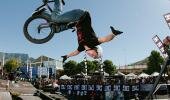Words: Patricia Alves
Capoeira: ka-po-ey-ra - Is it a dance, a game or combat? It is all of these elements combined that has made the art the worldwide phenomenon it is today and practiced by many individuals, regardless of their gender, race, creed and fitness levels.
With its origins in the 1500s, Capoeira was created in Brazil mainly by descendants of African slaves with Brazilian native influences. Musical instruments in the form of berimbau and drums, as well as singing and clapping were introduced by the slaves to camouflage its fighting style from their masters. This relatively unknown and exotic form of martial arts has since become recognised as an alternative to other better known art forms.
The berimbau is a bow-shaped instrument with a resonating gourd that sets the pace for the Capoeira game. It is the foundation on which Capoeira’s history is taught and through the use of songs, stories and messages are shared.
The prohibition of capoeira in 1890 forced practitioners to take on monikers to avoid persecution by the police. With its legal sanctioning in 1940, Capoeira became Brazil’s national sport and was even incorporated into military training.
Capoeira eventually took root in the USA and urban legend has it that it was the source of inspiration for breakdancing in New York in the late ‘70s.
With academies in every single continent, Capoeira has evolved from the obscure to the mainstream, being successfully utilised for different purposes.
The movie industry has been quick to latch onto the beauty of the art. In the ‘70s Kung-fu was the predominant style to be portrayed in films. It was later usurped by Bruce Lee’s Jeet Kune Do (JKD) and the ‘80s saw a slew of Karate-based motion pictures. Over the last decade Capoeira has been fortunate to have its internationalisation occur during a digitally creative period. Its fluidity and beauty has seen it being meshed in various film genres, such as in a comedy format in ‘Meet the Fockers’ and action movies like ‘Ocean’s Twelve’, to fantasy in ‘Æon Flux’.
The music industry has also had its fair share of Capoeira not only in its music clips, but also drawing on the various instruments used within the art that represent contrasting groups. These include heavy metal’s Soulfly and Sepultura, UK’s electronic band Leftfield, the eclectic Ben Harper and pop icons Madonna, Ricky Martin and the Black Eyed Peas.
Not wanting to be left out, the advertising industry has also frequently used Capoeira to target various audiences for products ranging from cell phones to bottled water, and in South Africa a well known Capoeira song was the principle jingle and pay-off line for a vehicle.
Now for the cynics - Capoeira is often stereotyped as simply a dance and not an effective fighting form. However, various professional MMA fighters are accomplished Capoeiristas (Capoeira practitioners), including Anderson Silva, a champion in various weight classes. It must also be remembered that the precursor to MMA in its current form, Vale-tudo was often the playground of many Capoeiristas, and Brazilian Jiu-Jitsu (BJJ) first cut its teeth against Capoeira.
The many benefits of Capoeira have been increasingly used to aid social projects from Haiti to Japan. Mestre Estivador, who runs the SA Capoeira Foundation, says, “Capoeira is a fantastic way of being able to contribute to society as a whole, as it has no limitations. It can be practiced by men, women and children of any race, creed, age and fitness level. The outcomes positively influence the individual and practical results are easily observed within a short space of time.”
Mestre Estivador explains that Capoeira is a microcosm of life in general, comparing the challenge of learning new movement to challenges in life. The analogies of the game become more evident as one continues practicing the art. You have to be able to deal with your opponent while being aware of outside influences, opportunities and threats, all this and more accompanied by a soundtrack!
In Capoeira, there is no contact. Instead of blocking as a defense, a Capoeirista will rather move away by way of evasive techniques, which usually leads to the opponent becoming defenceless.
Benefits of Capoeira
As an extreme cardiovascular workout it not only improves fitness, but coordination, strength, reflexes and the general well being of the mind and body.
Being people orientated its focus is not to fight, but rather a game and thereby improves social skills and promotes relationships and friendships where they did not previously exist. It also teaches people to treat each other as equals and develop self-control and discipline. As you improve, self-confidence is instilled.
Where it differs from many other arts is that it also has a cultural dimension through the teaching of the history of Capoeira, which is entwined with the history of Brazil and the African slave trade. With the movements come the music and once the instruments have been mastered, the songs go hand in hand.
Who would have thought that the practice of a martial art would also highlight the importance of music in one’s life, whilst improving the body, sharpens the mind and feeds the soul? But when all is said and done, Capoeira is what you make of it!
dinFO
Steve Grunberg, aka Mestre Estivador, a native Brazilian from Lapa in Sao Paulo, is a pioneer of Capoeira in South Africa. His academy, the South African Capoeira Foundation, was conceived in 1995 and is affiliated to the Federation of Sporting Capoeira of the State of Rio de Janeiro (FCDRJ) and Federation Pernambucana de Capoeira (FPC). He is also is very involved in Brazilian cultural activities such as Batala, an Afro-Brazilian percussion group and Brazilian dance forms, all of which are used as positive tools to coordinate various social projects.
Kids’ classes are a wonderful way to get your children active in a fun and pleasant environment. There is also a special programme available that focuses on parents and children training and spending quality time together.
For more details about the classes and other information, visit www.capoeira.co.za









